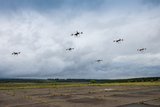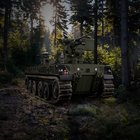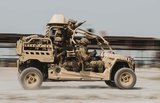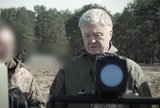USMC looks to unmanned future
‘Swarms’ of UAS will take over from manned aircraft in future operations the USMC Warfighting Laboratory is predicting and the change will need more precise control of airspace and networks.
This increase will be a stark comparison to recent trends, which have seen the number of manned aircraft being used reduced, resulting in one aircraft being used per collateral mission during Operation Iraqi Freedom and Operation Enduring Freedom.
It is envisaged that an ‘explosion’ of small UAS is the key to future mission success for the USMC, but this must be based on improving warfighting capability and not just be a ‘love-affair with technology’. In 2000 there were 50 unmanned aircraft in the USMC, and now there are some 8,000.
‘In ten years we are going to see an aircraft carrier with nothing on it but unmanned systems,’ Bill Powers of the USMC Warfighting Laboratory told the Defence IQ Air Weapons Integration conference in London on 25th May.
‘Budget is going to drive this more than anything,’ he continued, pointing out that a carrier-based aeroplane is the most expensive way ‘by far’ to aerially deliver a weapon.
‘You can buy squadrons of armed, ISR UAS for the price of one F-35B’, he added
Despite armed aerial platforms now being able to ‘plug and play’, which is deemed advantageous to the warfighter, Powers emphasised that on the future battlefield the military needs to rethink the way it plugs and unplugs into the net.
‘The amount of information available today is pretty much overwhelming. One solution I think is to be able to unplug from that network,’ commented Powers.
‘There are times that there is so much information there that we don’t care about.’
The Laboratory wants armed UAS to be able to ‘unplug’ from the big network, and instead link to its own local area network, tell it what to do for the day, and it will do it. Powers said he wants: ‘What we need when we need it, not everything all the time’.
In the past rotary wing and fixed wing aircraft have separated their airspace by altitude, but now UAVs such as the Tracker, Reaper and Shadow, will all fly at same altitude as the manned aircraft, and airspace needs to be controlled differently. C2 is therefore paramount to the USMC in these situations.
Alongside platform numbers, the impact and precision of targets has also changed, with lots of targets being taken out in each mission.
‘Now we can pretty much go out with one aeroplane, one or two weapons, and you’re pretty much sure you can take out the targets. We have far more systems in the air, and we are getting more and more systems that are plugging into the net,’ said Powers
‘There are so many sensors available in theatre now; we are overwhelmed with information available through the net’.
More from Uncrewed Vehicles
-
![Ready for the race: Air separation drone swarms vs. air defence systems]()
Ready for the race: Air separation drone swarms vs. air defence systems
As the dynamics of aerial combat rapidly evolve, Chinese scientists have engineered a sophisticated air separation drone model that can fragment into up to six drones, each capable of executing distinct battlefield roles and challenging the efficacy of current anti-drone defences such as the UK’s Dragonfire laser system.
-
![Israel’s MALE UAVs ‘must adapt’ to Iranian-made air defences]()
Israel’s MALE UAVs ‘must adapt’ to Iranian-made air defences
Advancements in air defence technologies have begun to reshape aerial combat dynamics in the Middle East, as illustrated by recent events involving the Israeli Air Force and Hezbollah.
-
![Hundreds more UAS sent to Ukraine forces with thousands more on the way]()
Hundreds more UAS sent to Ukraine forces with thousands more on the way
Both sides of the Russia-Ukraine war have been using UAS for effective low-cost attacks, as well as impactful web and social media footage. Thousands more have now been committed to Ukrainian forces.
-
![AI and software companies selected for US Army Robotic Combat Vehicle subsystems]()
AI and software companies selected for US Army Robotic Combat Vehicle subsystems
The US Army has intentions to develop light, medium and heavy variants of the Robotic Combat Vehicle (RCV) as part of the branche’s Next Generation Combat Vehicle family.
-
![DroneShield to improve software of DroneSentry-X C-UAS system under new contract]()
DroneShield to improve software of DroneSentry-X C-UAS system under new contract
DroneSentry-X, a cross-vehicle compatible, automated 360° C-UAS detect and defeat device, can offer 360° awareness and protection using integrated sensors. According to its manufacturer, it is suitable for mobile operations, on-site surveillance and on-the-move missions.
-
![Ukraine takes delivery of new indigenous C-UAS systems]()
Ukraine takes delivery of new indigenous C-UAS systems
Funded by the country’s former president, the new C-UAS systems will be sent to the frontline where they have already been tested against Russian invading forces.


























